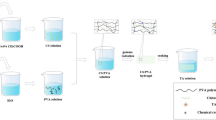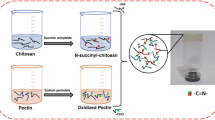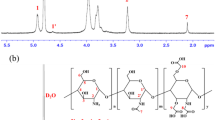Abstract
Hydrogel has high water content and structural similarity with natural extracellular matrix. So it has been widely studied and applied in the field of biomedicine. In order to further develop multifunctional hydrogels, we prepared mixed gels with anti-ultraviolet properties. This study found that the addition of polysaccharides and polyphenols was beneficial to the rheological, mechanical properties, and biological activity of the protein. Chitosan (CS) could significantly improve the viscoelasticity, hardness, gel strength, thermal stability and crystallinity of gelatin. Interestingly, the addition of gallic acid (GA) could not only provide significant cross-linking effect, improve gel properties and microstructure, but also improve the UV resistance of the mixed gel.
Similar content being viewed by others
References
Aduba Jr., D. C., An, S. S., Selders, G. S., Yeudall, W. A., Bowlin, G. L., Kitten, T., et al., 2019. Electrospun gelatin-arabinoxylan ferulate composite fibers for diabetic chronic wound dressing application. International Journal of Polymeric Materials and Polymeric Biomaterials, 68(11): 660–668.
Afshar, H. A., and Ghaee, A., 2016. Preparation of aminated chitosan/alginate scaffold containing halloysite nanotubes with improved cell attachment. Carbohydrate Polymers, 151: 1120–1131.
Al-Sherbini, A. S. A., Ghannam, E. A., El-Ghanam, M. A., and Youssef, A. M., 2019. Utilization of chitosan/Ag bionanocomposites as eco-friendly photocatalytic reactor for bactericidal effect and heavy metals removal. Heliyon, 5(6): e01980.
Anvari, M., and Chung, D. H., 2016. Dynamic rheological and structural characterization of fish gelatin-gum Arabic coacervate gels cross-linked by tannic acid. Food Hydrocolloids, 60: 516–524.
Azeredo, H. M., and Waldron, K. W., 2016. Crosslinking in polysaccharide and protein films and coatings for food contact — A review. Trends in Food Science & Technology, 52: 109–122.
Bertolo, M. R., Martins, V. C., Horn, M. M., Brenelli, L. B., and Plepis, A. M., 2020. Rheological and antioxidant properties of chitosan/gelatin-based materials functionalized by pomegranate peel extract. Carbohydrate Polymers, 228: 115386.
Chen, C., Takahashi, K., Geonzon, L., Okazaki, E., and Osako, K., 2019. Texture enhancement of salted Alaska pollock (Theragra chalcogramma) roe using microbial transglutaminase. Food Chemistry, 290: 196–200.
Chu, L. L., Yang, L. C., Li, J. E., Lin, L. Z., and Zheng, G. D., 2019. Effect of Smilax china L. starch on the gel properties and interactions of calcium sulfate-induced soy protein isolate gel. International Journal of Biological Macromolecules, 135: 127–132.
Cui, L., Xiong, Z. H., Guo, Y., Liu, Y., Zhao, J. C., Zhang, C. J., et al., 2015. Fabrication of interpenetrating polymer network chitosan/gelatin porous materials and study on dye adsorption properties. Carbohydrate Polymers, 132: 330–337.
de Jong, S., van Vliet, T., and de Jongh, H. H., 2015. The contribution of time-dependent stress relaxation in protein gels to the recoverable energy that is used as a tool to describe food texture. Mechanics of Time-Dependent Materials, 19(4): 505–518.
Di Donato, P., Taurisano, V., Poli, A., d’Ayala, G. G., Nicolaus, B., Malinconinco, M., et al., 2020. Vegetable wastes derived polysaccharides as natural eco-friendly plasticizers of sodium alginate. Carbohydrate Polymers, 229: 115427.
Diez-Sales, O., Dolz, M., Hernandez, M. J., Casanovas, A., and Herraez, M., 2007. Rheological characterization of chitosan matrices: Influence of biopolymer concentration. Journal of Applied Polymer Science, 105(4): 2121–2128.
Ding, M. Z., Zhang, T., Zhang, H., Tao, N. P., Wang, X. C., and Zhong, J., 2020. Gelatin molecular structures affect behaviors of fish oil-loaded traditional and Pickering emulsions. Food Chemistry, 309: 125642.
El-Sayed, S. M., El-Sayed, H. S., Ibrahim, O. A., and Youssef, A. M., 2020. Rational design of chitosan/guar gum/zinc oxide bionanocomposites based on Roselle calyx extract for Ras cheese coating. Carbohydrate Polymers, 239: 116234.
Farris, S., Schaich, K. M., Liu, L., Cooke, P. H., Piergiovanni, L., and Yam, K. L., 2011. Gelatin-pectin composite films from polyion-complex hydrogels. Food Hydrocolloids, 25(1): 61–70.
Feng, S., Sun, Y., Wang, P., Sun, P., Ritzoulis, C., and Shao, P., 2019. Co-encapsulation of resveratrol and epigallocatechin gallate in low methoxyl pectin-coated liposomes with great stability in orange juice. International Journal of Food Science and Technology, 55(5): 1872–1880.
Hedayatnia, S., Tan, C. P., Kam, W. L. J., Tan, T. B., and Mirhosseini, H., 2019. Modification of physicochemical and mechanical properties of a new bio-based gelatin composite films through composition adjustment and instantizing process. LWT — Food Science and Technology, 116: 108575.
Hu, B., Chen, Q., Cai, Q. M., Fan, Y., Wilde, P. J., Rong, Z., et al., 2017. Gelation of soybean protein and polysaccharides delays digestion. Food Chemistry, 221: 1598–1605.
Huang, J. J., Zeng, S. W., Xiong, S. B., and Huang, Q. L., 2016. Steady, dynamic, and creep-recovery rheological properties of myofibrillar protein from grass carp muscle. Food Hydrocolloids, 61: 48–56.
Jin, R., Teixeira, L. M., Dijkstra, P. J., Karperien, M., Van Blitterswijk, C. A., Zhong, Z. Y., et al., 2009. Injectable chitosan-based hydrogels for cartilage tissue engineering. Biomaterials, 30(13): 2544–2551.
Kim, W. T., Chung, H., Shin, I. S., Yam, K. L., and Chung, D., 2008. Characterization of calcium alginate and chitosan-treated calcium alginate gel beads entrapping allyl isothiocyanate. Carbohydrate Polymers, 71(4): 566–573.
Li, W. Q., Wu, D. W., Hu, D., Zhu, S. S., Pan, C., Jiao, Y. P., et al., 2020. Stress-relaxing double-network hydrogel for chondrogenic differentiation of stem cells. Materials Science and Engineering: C, 107: 110333.
Li, X., Chen, S., Li, J. E., Wang, N., Liu, X., An, Q., et al., 2019. Chemical composition and antioxidant activities of polysaccharides from Yingshan Cloud Mist tea. Oxidative Medicine and Cellular Longevity, 2019: 1915967.
Lin, T. K., Zhong, L., and Santiago, J. L., 2018. Anti-inflammatory and skin barrier repair effects of topical application of some plant oils. International Journal of Molecular Sciences, 19(1): 70.
Liu, P. Y., and Zhen, W. J., 2018. Structure-property relationship, rheological behavior, and thermal degradability of poly (lactic acid)/fulvic acid amide composites. Polymers for Advanced Technologies, 29(8): 2192–2203.
Moon, J. H., Yoon, W. B., and Park, J. W., 2017. Assessing the textural properties of Pacific whiting and Alaska pollock surimi gels prepared with carrot under various heating rates. Food Bioscience, 20: 12–18.
Muhoza, B., Xia, S. Q., and Zhang, X. M., 2019. Gelatin and high methyl pectin coacervates crosslinked with tannic acid: The characterization, rheological properties, and application for peppermint oil microencapsulation. Food Hydrocolloids, 97: 105174.
Nadzharyan, T. A., Kostrov, S. A., Stepanov, G. V., and Kramarenko, E. Y., 2018. Fractional rheological models of dynamic mechanical behavior of magnetoactive elastomers in magnetic fields. Polymer, 142: 316–329.
Naidoo, K., Hanna, R., and Birch-Machin, M. A., 2018. What is the role of mitochondrial dysfunction in skin photoaging?. Experimental Dermatology, 27(2): 124–128.
Nair, S., Remya, N. S., Remya, S., and Nair, P. D., 2011. A biodegradable in situ injectable hydrogel based on chitosan and oxidized hyaluronic acid for tissue engineering applications. Carbohydrate Polymers, 85(4): 838–844.
Patel, A. R., Dumlu, P., Vermeir, L., Lewille, B., Lesaffer, A., and Dewettinck, K., 2015. Rheological characterization of gel-in-oil-in-gel type structured emulsions. Food Hydrocolloids, 46: 84–92.
Peng, X., and Yao, Y., 2018. Small-granule starches from sweet corn and cow cockle: Physical properties and amylopectin branching pattern. Food Hydrocolloids, 74: 349–357.
Petcharat, T., and Benjakul, S., 2018. Effect of gellan incorporation on gel properties of bigeye snapper surimi. Food Hydrocolloids, 77: 746–753.
Qian, Y., Zhong, X. W., Li, Y., and Qiu, X. Q., 2017. Fabrication of uniform lignin colloidal spheres for developing natural broad-spectrum sunscreens with high sun protection factor. Industrial Crops and Products, 101: 54–60.
Quan, T. H., Benjakul, S., Sae-leaw, T., Balange, A. K., and Maqsood, S., 2019. Protein-polyphenol conjugates: Antioxidant property, functionalities and their applications. Trends in Food Science & Technology, 91: 507–517.
Razmkhah, S., Razavi, S. M. A., and Mohammadifar, M. A., 2017. Dilute solution, flow behavior, thixotropy and viscoelastic characterization of cress seed (Lepidium sativum) gum fractions. Food Hydrocolloids, 63: 404–413.
Rui, L. Y., Xie, M. H., Hu, B., Zhou, L., Yin, D. Y., and Zeng, X. X., 2017. A comparative study on chitosan/gelatin composite films with conjugated or incorporated gallic acid. Carbohydrate Polymers, 173: 473–481.
Sadeghifar, H., Venditti, R., Jur, J., Gorga, R. E., and Pawlak, J. J., 2016. Cellulose-lignin biodegradable and flexible UV protection film. ACS Sustainable Chemistry & Engineering, 5(1): 625–631.
Shao, P., Feng, J., Sun, P., and Ritzoulis, C., 2019. Improved emulsion stability and resveratrol encapsulation by whey protein/gum arabic interaction at oil-water interface. International Journal of Biological Macromolecules, 133: 466–472.
Shao, P., Niu, B., Chen, H. J., and Sun, P. L., 2017. Fabrication and characterization of tea polyphenols loaded pullulan-cmc electrospun nanofiber for fruit preservation. International Journal of Biological Macromolecules, 107: 1908–1914.
Shao, P., Zhang, H., Niu, B., and Jin, W., 2018. Physical stabilities of taro starch nanoparticles stabilized Pickering emulsions and the potential application of encapsulated tea polyphenols. International Journal of Biological Macromolecules, 118: 2032–2039.
Sow, L. C., Toh, N. Z. Y., Wong, C. W., and Yang, H., 2019. Combination of sodium alginate with tilapia fish gelatin for improved texture properties and nanostructure modification. Food Hydrocolloids, 94: 459–467.
Sun, Y., Liu, Z. L., Zhang, L. M., Wang, X. M., and Li, L., 2019. Effects of plasticizer type and concentration on rheological, physico-mechanical and structural properties of chitosan/zein film. International Journal of Biological Macromolecules, 143(1): 334–340.
Tobin, D. J., 2017. Introduction to skin aging. Journal of Tissue Viability, 26(1): 37–46.
Wang, F. P., Pang, Y. N., Chen, G. B., Wang, W. W., and Chen, Z. M., 2020. Enhanced physical and biological properties of chitosan scaffold by silk proteins cross-linking. Carbohydrate Polymers, 229: 115529.
Wang, H. P., Gong, X. C., Miao, Y. L., Guo, X., Liu, C., Fan, Y. Y., et al., 2019a. Preparation and characterization of multilayer films composed of chitosan, sodium alginate and carboxymethyl chitosan-ZnO nanoparticles. Food Chemistry, 283: 397–403.
Wang, W. J., Jiang, L., Ren, Y. M., Shen, M. Y., and Xie, J. H., 2019b. Gelling mechanism and interactions of polysaccharides from Mesona blumes: Role of urea and calcium ions. Carbohydrate Polymers, 212: 270–276.
Wang, W. J., Shen, M. Y., Jiang, L., Song, Q. Q., Liu, S. C., Xie, M. Y., et al., 2019c. Rheological behavior, microstructure characterization and formation mechanism of Mesona blumes polysaccharide gels induced by calcium ions. Food Hydrocolloids, 94: 136–143.
Wang, W. J., Shen, M. Y., Liu, S. C., Jiang, L., Song, Q. Q., and Xie, J. H., 2018. Gel properties and interactions of Mesona blumes polysaccharide-soy protein isolates mixed gel: The effect of salt addition. Carbohydrate Polymers, 192: 193–201.
Wang, Y., Li, T., Ma, P. M., Bai, H. Y., Xie, Y., Chen, M. Q., et al., 2016. Simultaneous enhancements of UV-shielding properties and photostability of poly(vinyl alcohol) via incorporation of sepia eumelanin. ACS Sustainable Chemistry & Engineering, 4(4): 2252–2258.
Wu, C. H., Tian, J. H., Li, S., Wu, T. T., Hu, Y. Q., Chen, S. G., et al., 2016. Structural properties of films and rheology of film-forming solutions of chitosan gallate for food packaging. Carbohydrate Polymers, 146: 10–19.
Xiong, L., Ouyang, K. H., Jiang, Y., Yang, Z. W., Hu, W. B., Chen, H., et al., 2018. Chemical composition of Cyclocarya paliurus polysaccharide and inflammatory effects in lipopolysaccharide-stimulated RAW264.7 macrophage. International Journal of Biological Macromolecules, 107: 1898–1907.
Youssef, A. M., Assem, F. M., and Abdel-Aziz, M. E., 2018. Development of bionanocomposite materials and its use in coating of Ras cheese. Food Chemistry, 270: 467–475.
Zhong, A. H., Qiu, P. Q., and Wang, D., 2002. Mechanism of protection from ultraviolet radiation (UVR) and product development thereof. Textile Auxiliaries, 3: 43–45.
Zhuang, X. B., Jiang, X. P., Han, M. Y., Kang, Z. L., Zhao, L., Xu, X. L., et al., 2016. Influence of sugarcane dietary fiber on water states and microstructure of myofibrillar protein gels. Food Hydrocolloids, 57: 253–261.
Acknowledgements
This work was supported by the National Natural Science Foundation of China (No. 31922072), the China Agriculture Research System (No. CARS-48), the Fundamental Research Funds for the Central Universities (No. 2019 41002), the Taishan Scholar Project of Shandong Province (No. tsqn201812020).
Author information
Authors and Affiliations
Corresponding author
Rights and permissions
About this article
Cite this article
Wang, W., Xue, C. & Mao, X. Properties and Anti-Ultraviolet Activity of Gallic Acid-Chitosan-Gelatin Mixed Gel. J. Ocean Univ. China 21, 204–212 (2022). https://doi.org/10.1007/s11802-022-4820-x
Received:
Revised:
Accepted:
Published:
Issue Date:
DOI: https://doi.org/10.1007/s11802-022-4820-x




